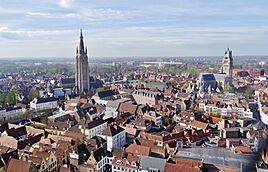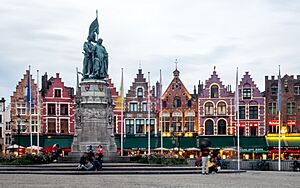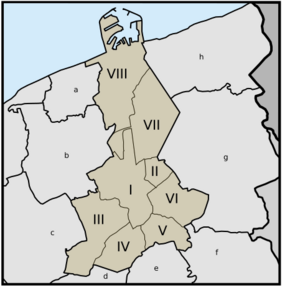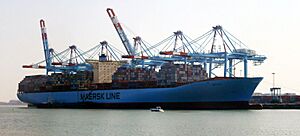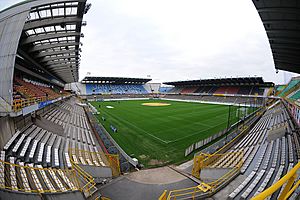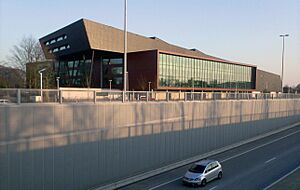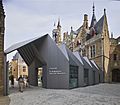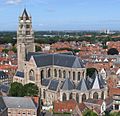Bruges facts for kids
Quick facts for kids
Bruges
Brugge (Dutch)
|
|||||||||||||||||
|---|---|---|---|---|---|---|---|---|---|---|---|---|---|---|---|---|---|
|
Southwestern view from the Belfry, with the Church of Our Lady and St. Salvator's Cathedral in the background
Concertgebouw
Canal view with Belfry in the background
Zeebrugge beach and outer port
|
|||||||||||||||||
|
|||||||||||||||||
| Country | Belgium | ||||||||||||||||
| Community | Flemish Community | ||||||||||||||||
| Region | Flemish Region | ||||||||||||||||
| Province | West Flanders | ||||||||||||||||
| Arrondissement | Bruges | ||||||||||||||||
| Area | |||||||||||||||||
| • Total | 138.40 km2 (53.44 sq mi) | ||||||||||||||||
| Population
(2018-01-01)Lua error in Module:Wd at line 1575: attempt to index field 'wikibase' (a nil value).
|
|||||||||||||||||
| • Total | Lua error in Module:Wd at line 1,575: attempt to index field 'wikibase' (a nil value). | ||||||||||||||||
| Postal codes |
8000, 8200, 8310, 8380
|
||||||||||||||||
| Area codes | 050 | ||||||||||||||||
|
|||||||||||||||||
|
|
|||||||||||||||||
Bruges (pronounced BROOZH) is a beautiful city in Belgium. It is the capital and largest city of the West Flanders province. You can find it in the northwest part of the country. Bruges is the sixth biggest city in Belgium.
The city covers a large area, including a part near the coast called Zeebrugge. This name means 'Bruges by the Sea'. The old part of Bruges is a special place. It is recognized by UNESCO as a World Heritage Site. This means it is very important to the world's history and culture. About 20,000 people live in this historic city center.
Bruges is often called the "Venice of the North". This is because it has many canals, just like Venice in Italy. The city has always been important for trade. It was once one of the world's main trading cities. Today, Bruges is a popular place for tourists to visit. It is also home to the College of Europe, a university for European studies.
Contents
- What's in a Name? The Story of Bruges
- A Journey Through Time: The History of Bruges
- Exploring Bruges: Geography and Neighborhoods
- Weather in Bruges
- Landmarks, Arts, and Culture in Bruges
- Getting Around Bruges: Transport
- Who Lives in Bruges? Demographics
- Sports in Bruges
- Learning in Bruges: Education
- City Partnerships
- Images for kids
- See also
What's in a Name? The Story of Bruges
The name Bruges has a long history. It was first mentioned around 840 AD. The name probably comes from an old Dutch word for 'bridge', which was brugga. This makes sense because Bruges has many bridges over its canals. The English word 'bridge' also comes from the same ancient root.
A Journey Through Time: The History of Bruges
Bruges has been a place where people lived for a very long time. Early settlements were here even before the Middle Ages.
How Bruges Began
The first forts in the Bruges area were built by the Romans. This was around the first century BC. They wanted to protect the coast from pirates. Later, in the 800s, Viking raiders attacked. This led to stronger forts being built. Trade with England and other northern countries soon started.
Bruges' Golden Age (1100s to 1400s)
In 1089, Bruges became the capital of the area called County of Flanders. The city got its official city rights on July 27, 1128. New walls and canals were built around the city.
A natural waterway called Het Zwin was very important. It connected Bruges directly to the sea. This helped the city become a major trading hub. Ships from all over Europe came here. Bruges was a meeting point for trade routes from the north and the south.
Merchants in Bruges were very smart. They created new ways of doing business. They used things like bills of exchange. This made trading easier and safer. Foreign traders were always welcome. People from Portugal sold spices. Traders from Genoa (Italy) brought goods from the Mediterranean Sea. The first stock exchange in the world might have opened here in 1309.
The city became very rich from its wool and cloth industries. Bruges wool was known as the best. This wealth sometimes led to problems. In 1302, the people of Bruges fought against the French. This led to the Battle of the Golden Spurs. The people of Bruges won! You can still see statues of the leaders, Jan Breydel and Pieter de Coninck, in the main market square.
By the 1400s, Bruges was a very important city. The Duke of Burgundy, Philip the Good, even had a court here. Many famous artists and bankers came to live in Bruges. The city's population grew to over 46,000 people. New painting styles, like oil painting, became famous here. The first book ever printed in English was made in Bruges by William Caxton.
Bruges' Decline and Revival
Around 1500, the Zwin channel, which connected Bruges to the sea, started to fill up with sand. This meant large ships could no longer reach the city easily. Bruges began to lose its importance. The city of Antwerp became the main trading center in the region.
Bruges became poorer. In the 1600s, the lace industry grew. But the city never fully got back its old glory. It became known as a "dead city" in some stories.
A New Beginning (1800s and Beyond)
In the late 1800s, Bruges started to become a popular place for tourists. Wealthy visitors from Britain and France came to see its historic beauty.
During both World War I and World War II, German forces occupied Bruges. Luckily, the city was not badly damaged in either war. It was freed by Canadian troops in 1944.
After 1965, the old medieval city center began to shine again. Buildings were restored, and tourism boomed. In 2002, Bruges was named the European Capital of Culture. Today, about eight million tourists visit Bruges every year!
The Port of Zeebrugge was built in 1907. It became very important for trade. It is now one of Europe's biggest and most modern ports.
Exploring Bruges: Geography and Neighborhoods
The city of Bruges is made up of several smaller areas. These include the historic city center and nearby towns. Some of these areas are:
- The historic city center of Bruges, along with Sint-Jozef and Sint-Pieters.
- Koolkerke.
- Sint-Andries.
- Sint-Michiels.
- Assebroek.
- Sint-Kruis.
- Dudzele.
- Lissewege (which includes Zeebrugge and Zwankendamme).
Weather in Bruges
Bruges has an oceanic climate. This means it has mild winters and cool summers. It gets rain throughout the year.
| Climate data for Bruges (1981–2010 normals, sunshine 1984–2013) | |||||||||||||
|---|---|---|---|---|---|---|---|---|---|---|---|---|---|
| Month | Jan | Feb | Mar | Apr | May | Jun | Jul | Aug | Sep | Oct | Nov | Dec | Year |
| Mean daily maximum °C (°F) | 6.2 (43.2) |
7.0 (44.6) |
10.8 (51.4) |
14.5 (58.1) |
17.4 (63.3) |
19.9 (67.8) |
22.4 (72.3) |
22.5 (72.5) |
19.7 (67.5) |
15.3 (59.5) |
10.1 (50.2) |
6.6 (43.9) |
14.7 (58.5) |
| Daily mean °C (°F) | 3.6 (38.5) |
3.8 (38.8) |
6.8 (44.2) |
9.3 (48.7) |
12.9 (55.2) |
15.6 (60.1) |
17.9 (64.2) |
17.9 (64.2) |
15.0 (59.0) |
11.3 (52.3) |
7.1 (44.8) |
4.1 (39.4) |
10.6 (51.1) |
| Mean daily minimum °C (°F) | 0.9 (33.6) |
0.6 (33.1) |
2.8 (37.0) |
4.5 (40.1) |
8.4 (47.1) |
11.3 (52.3) |
13.3 (55.9) |
12.9 (55.2) |
10.4 (50.7) |
7.4 (45.3) |
4.2 (39.6) |
1.7 (35.1) |
6.5 (43.7) |
| Average precipitation mm (inches) | 66.5 (2.62) |
55.8 (2.20) |
58.0 (2.28) |
44.2 (1.74) |
61.5 (2.42) |
68.5 (2.70) |
71.3 (2.81) |
79.0 (3.11) |
79.2 (3.12) |
84.8 (3.34) |
86.1 (3.39) |
81.1 (3.19) |
836.2 (32.92) |
| Average precipitation days | 12.6 | 10.6 | 11.8 | 9.7 | 10.7 | 10.0 | 9.9 | 9.9 | 10.8 | 12.1 | 13.7 | 13.3 | 135.1 |
| Mean monthly sunshine hours | 63 | 83 | 130 | 187 | 217 | 211 | 221 | 208 | 152 | 118 | 65 | 51 | 1,705 |
| Source: Royal Meteorological Institute | |||||||||||||
Landmarks, Arts, and Culture in Bruges
Bruges is famous for its well-preserved medieval buildings. It feels like stepping back in time! The "Historic Centre of Bruges" is a UNESCO World Heritage Site.
Famous Buildings and Sites
- Church of Our Lady: This church has a very tall brick tower. It is one of the tallest brick buildings in the world. Inside, you can see a famous sculpture called Madonna and Child by Michelangelo.
- Belfry of Bruges: This 13th-century tower is a symbol of Bruges. It has 47 bells that play music. The city even has a special musician, called a carillonneur, who plays the bells regularly. This belfry is also a UNESCO World Heritage Site.
- Ten Wijngaerde Béguinage: This is another UNESCO World Heritage Site in Bruges. It was built in the 1200s. A béguinage was a community where religious women lived together.
Crafts and Local Delights
Bruges is well-known for its beautiful bobbin lace. This is a special way of making fabric.
The city also has several beers named after it. Two of them, Brugse Zot and Brugse Straffe Hendrik, are still brewed right in the city at the De Halve Maan Brewery.
Fun Things to Do: Entertainment and Festivals
Bruges offers many fun activities and events.
Entertainment Venues
- Boudewijn Seapark: An amusement park with a dolphinarium.
- Concertgebouw: A modern concert hall.
- Kinepolis Bruges: A large movie theater.
Festivals All Year Round
Bruges hosts many festivals, celebrating music, culture, and food!
- Music Festivals: Blues in Bruges, Cactusfestival, Jazz Brugge, and the MAfestival (for old music).
- Cultural and Food Festivals: BAB-bierfestival (beer festival), Choco-Laté (chocolate festival), Cinema Novo (film festival), and Ice Magic (ice sculpture festival).
- Other Fun Festivals: Klinkers (free concerts) and Polé Polé Beach (a dance festival in Zeebrugge).
Museums and Historic Sites (Non-Religious)
Bruges has many museums where you can learn about art and history.
- Art Museums: The Groeningemuseum has a great collection of old art. You can see paintings by famous artists like Jan van Eyck and Hans Memling, who lived and worked in Bruges.
- Old City Gates: You can still see four of the old city gates: the Kruispoort, the Gentpoort, the Smedenpoort, and the Ezelpoort.
- Bruggemuseum: This is a group of 11 different historical museums. They include:
- Gruuthusemuseum: A museum in a historic house.
- Belfry: The famous bell tower.
- City Hall: Located on the Burg square.
- Museum of Folklore: Learn about local traditions.
- Other Museums: You can also visit the Chocolate Museum (Choco-Story), the Diamond Museum, and the Frietmuseum (a museum all about Belgian fries!).
Religious Landmarks
Bruges has many beautiful churches and religious sites.
- Basilica of the Holy Blood: This church holds a very special relic, believed to be a drop of the Blood of Christ. Every year, there is a big parade called the Procession of the Holy Blood. Over 1,600 people dress up in medieval costumes for this event.
- St. Salvator's Cathedral: This is the main church of Bruges.
- Church of Our Lady: Mentioned earlier for its tall tower and Michelangelo sculpture.
Getting Around Bruges: Transport
Bruges is easy to get to and travel around.
Road Travel
Bruges is connected by major highways to other cities in Belgium and France. If you drive into the historic center, there are special rules. Cars are encouraged to park in large car parks. These car parks are not expensive and are close to the main tourist areas.
Train Travel
Bruges' main train station connects the city to the Belgian coast. You can also take trains to all other major cities in Belgium. There are also trains to Lille in France. The station is only a 10-minute walk from the main shopping streets.
Air Travel
The closest major airport is Brussels Airport, about an hour away by train or car. There is also a smaller airport, Ostend-Bruges International Airport, about 25 km away.
Public City Transport
Bruges has a good bus system run by De Lijn. Buses go all over the city and to nearby towns. If you park your car at the main train station, you can even get free bus rides into the city center!
Cycling in Bruges
Bruges is a great city for cycling. While cars are allowed on most streets, they must yield to bikes and pedestrians. Many streets allow bikes to travel in both directions. Thousands of people cycle in Bruges every day.
The Port of Zeebrugge
The port of Bruges is located at Zeebrugge, which means "Bruges-on-Sea." It is a very important and modern port in Europe.
Who Lives in Bruges? Demographics
Bruges is the sixth most populated city in Belgium. It is home to people from many different backgrounds.
| Group of origin | Year | |
|---|---|---|
| 2023 | ||
| Number | % | |
| Belgians with Belgian background | 97,936 | 81.93% |
| Belgians with foreign background | 12,006 | 10.04% |
| Neighbouring country | 2,433 | 2.04% |
| EU27 (excluding neighbouring country) | 1,350 | 1.13% |
| Outside EU 27 | 8,223 | 6.88% |
| Non-Belgians | 9,599 | 8.03% |
| Neighbouring country | 1,541 | 1.29% |
| EU27 (excluding neighbouring country) | 3,266 | 2.73% |
| Outside EU 27 | 4,792 | 4.01% |
| Total | 119,541 | 100% |
Sports in Bruges
Sports are very popular in Bruges.
- Cycling: Bruges used to host the start of the Tour of Flanders, a very big bike race.
- Football (Soccer): Bruges has two professional football teams: Club Brugge K.V. and Cercle Brugge K.S.V.. Both teams play in the top league in Belgium. They share the Jan Breydel Stadium, which can hold 30,000 fans. Bruges was also one of the host cities for the UEFA Euro 2000 football championship.
Learning in Bruges: Education
Bruges is an important center for education. Besides many schools, it has several colleges like VIVES and HOWEST. The city is also home to the College of Europe, a well-known place for advanced studies in European topics.
City Partnerships
Bruges does not officially have "twin towns" or "sister cities." However, it has had friendly connections with other cities over the years.
- Bastogne, Belgium: After World War II, Bruges helped children from Bastogne by offering them free holidays by the sea.
- Salamanca, Spain: Both cities were named European Capital of Culture in 2002, leading to some cultural exchanges.
- Mons, Belgium: In 2007, Bruges and Mons started working together on cultural and artistic projects.
- Burgos, Spain: In 2007, the mayors of Bruges and Burgos signed an agreement to cooperate on culture, tourism, and business.
Images for kids
-
The annual procession of the Holy Blood of Jesus Christ, UNESCO heritage
See also
 In Spanish: Brujas para niños
In Spanish: Brujas para niños


